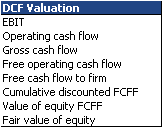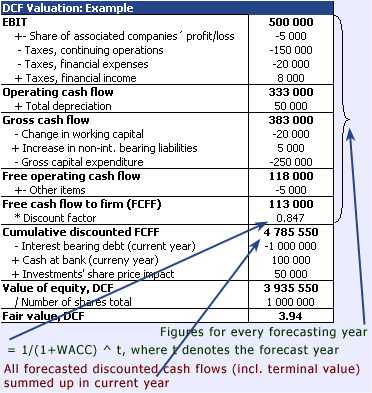|
The purpose of DCF-Valuation is to determine the value
of a company in terms of its future cash flows. The cash
flows are adjusted with certain items (e.g. those not
related to company´s core businesses or those with
no cash effect) in order to make sure the flows reflect
the actually generated cash as good as possible.
This document describes DCF valuation in detail and in
our valuation model. If your would like to get an overview
of valuation in general or practical examples (numerical
and graphical) about it, then
you should look at our valuation tutorial. (It
approaches equity valuation first with EVA instead of
DCF but as the tutorial reveals EVA approach is only an
another name for the old familiar DCF valuation. Both
end up to identical end result i.e. identical equity valuation.
)
The underlying idea of DCF-Valuation is to compute the
fair value of a company i.e. the intrinsinc value
of the company´s share. The potential of
the share price (which the investors are particularly
interested in) is then computed by comparing the fair
value with the current market price of the company´s
share.
The basic formulation of Discounted cash flow valuation
is as follows:

 |
Free cash flow to firm is discounted with
WACC to the Year
0 (the forecast year) in order to get the present
value of free cash flows.
|
 |
Cumulative discounted
free cash flow is
a yearly item in which all the forecast years´
discounted cash flows are summed up. Hence, the
first item is the sum of all forecast years´
free cash flows at present value terms.
|
 |
Value of equity FCFF is divided by the number
of shares outstanding to get the fair value
of the company´s share.
|
More detailed formulation of Discounted cash flow valuation
is as follows:

 |
EBIT is adjusted with with Taxes and
Share of associated companies´ profit/loss
in order to get Operating cash flow -
the figure that reflects the cash actually generated
by the company much better than the EBIT (accounting
figure).
|
 |
Operating cash flow is adjusted with Total
depreciation to get Gross cash flow.
This has to be done because depreciation
has no cash effect and thus does not really reduce
the cash generated.
|
 |
Gross cash flow includes cash tied up in
investments. Hence, Change in working capital
and Gross capital expenditure have to
be subtracted from it and Increase in non-interest
bearing liabilities added to it in order to
get Free operating cash flow.
Change in working capital appears in the
calculation as minus-signed if more capital is tied
up in the business than in the previous year. Gross
capital expenditure in turn is the cash used
for investments during the year. Increase in
non-interest bearing liabilities is plus-signed,
since it has an opposite effect than Net working
capital.
|
 |
Other items include extraordinary items,
which have a cash effect even though they are not
important in a operational business sense.
|
 |
Interest bearing debt, Cash at bank and
Investments' share price impact are to be
added/subtracted from the Cumulative discounted
cash flow so that the result of the valuation
is Value of equity, not Value of firm.
|
All items except for EBIT, Share of associated companies´
profit/loss and Taxes on continuing operations
the model calculates automatically. Thus, you can freely
change EBIT, Share of associated companies´ profit/loss
and Taxes on continuing operations (and naturally
all the subitems which are blue).
See equations for the DCF-valuation
items.
|

















